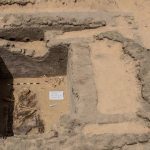The Mystery Of the Pyramid Of Giza
For years and years, archaeologists have had questions regarding the Great Pyramid of Giza. Because there was no heavy machinery back then, they wonder how the enormous stone blocks that were used to construct the pyramids got to the site in the first place. Its sheer size makes it seem impossible.
The Great Pyramid
The Great Pyramid is located in Giza. It is about a 20-minute drive from the center of Cairo, which is the capital of Egypt. The pyramid was built by the pharaoh, Khufu about 4,500 years ago. People have wondered about this structure for years. Experts have always had different opinions, and they argued about how the huge blocks were brought to the area.
The Size of the Great Pyramid
When the pyramid was complete, it was 480-feet tall. Over the years, the height had diminished somewhat due to centuries of desert erosion. For over 3,800 years, the pyramid was the tallest structure in the world. This all changed in 1300 when the Lincoln Cathedral was completed. The 520-foot spire is what made it the tallest structure. It didn’t hold the title for long because, in 1549, the spire was blown down during a storm. When this happened, the Great Pyramid reclaimed its title.
Answers?
Today, French researchers believe that they have the answers to how the Great Pyramid was constructed. Scientists have deciphered an ancient scroll that could solve the mystery of the Pyramid of Giza. They are hoping that this will give them some answers. Based on the sheer size of the blocks, it seems impossible.
The Makeup Of the Pyramids
Based on raw statistics, it took about 2.3 million blocks to build it. The largest blocks weighted up to 80-tons each. The pyramid needed about 6-million tons of limestone and 9-million tons of granite. The granite had to be brought in from Aswan which was 420-miles away. Without motorized vehicles, it makes you wonder how this was possible.
Pierre Tallet
The man who may have some answers is Pierre Tallet. He is a French archaeologist who studied at the prestigious Ecole Normale Superieure in Paris. His links to Egypt began when he began working as a teacher there. He has studied more than the Great Pyramid. He has also studied other Egyptian sites that are less well known. He has dedicated most of his life to these structures and to discovering more about them.
The First Breakthrough
Tallet’s first breakthrough came when he found a series of horizontal underground passages near the Red Sea. These passages have been sealed up for a long time. Tallet believes that the chambers were used by the ancient Egyptians as a place to store their boats. He made this discovery at Ayn Soukhna. This is a popular tourist resort on the west bank of the Red Sea. It is about 70-miles east of Giza. It was never considered a site of archaeological significance; however, in 1997, ancient hieroglyphs were found carved in the cliff, and the area was considered to be important. Tallet’s find was in the same period that the Pharoah Khufu’s Great Pyramid was constructed. According to Tallet, he found a sophisticated harbor complex. He believes that this location was used to transport the materials to the Great Pyramid.
The Second Find
The second major find was another harbor site called Wadi al-Jarf on the Red Sea. In 1823, an English archaeologist named Sir John Gardner Wilkinson visited the area. He misinterpreted what he saw there. He assumed that the chambers cut into the rock face at the site were catacombs. Tallet knew that two French pilots were stationed in Egypt in the 1950s and had visited the area. One of them was still alive, and he told Tallet what he knew. These notes, combined with GPS brought him to the site.
Exploring
Tallet and his team gained entrance by removing some of the massive stones. Inside, they found a scroll, complete with photos that explained how the rocks got to the site. He also found a diary written by an official named Mercer. He was the leader of a team of 200 men whose job it was to transport goods around Egypt. It was dated 4,500-years ago which was when the Great Pyramid was built. The diary also mentions a journey to Tura, which is a town on the River Nile where limestone for the construction of the Great Pyramid was quarried. Today, the diary is housed at Boston’s Museum Of Fine Arts for everyone to see. This isn’t solid evidence, but it is the most information we have been able to find thus far. Finally, we are getting answers to this centuries-old mystery.


